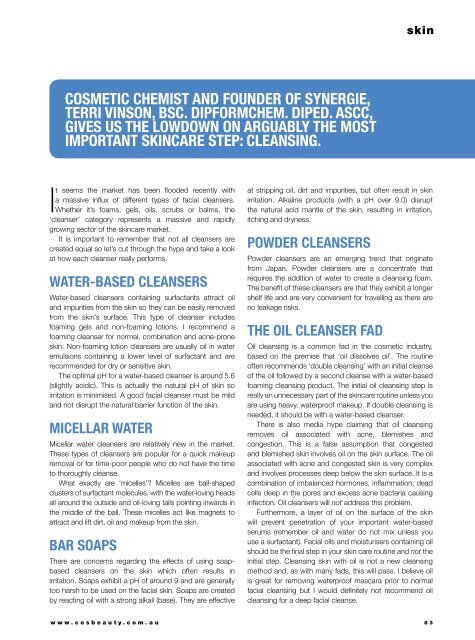Cosmetic Surgery & Beauty #72
Cosmetic Surgery and Beauty is the definitive consumer guide to aesthetic enhancement in Australia. Written by medical journalists and industry experts CSBM covers everything you need to know and with hundreds of untouched before and after photos it is the authoritative information source.
Cosmetic Surgery and Beauty is the definitive consumer guide to aesthetic enhancement in Australia. Written by medical journalists and industry experts CSBM covers everything you need to know and with hundreds of untouched before and after photos it is the authoritative information source.
Create successful ePaper yourself
Turn your PDF publications into a flip-book with our unique Google optimized e-Paper software.
skin<br />
<strong>Cosmetic</strong> chemist and founder of Synergie,<br />
Terri Vinson, Bsc. DipFormChem. DipEd. ASCC,<br />
gives us the lowdown on arguably the most<br />
important skincare step: cleansing.<br />
It seems the market has been flooded recently with<br />
a massive influx of different types of facial cleansers.<br />
Whether it’s foams, gels, oils, scrubs or balms, the<br />
‘cleanser’ category represents a massive and rapidly<br />
growing sector of the skincare market.<br />
It is important to remember that not all cleansers are<br />
created equal so let’s cut through the hype and take a look<br />
at how each cleanser really performs.<br />
Water-based cleansers<br />
Water-based cleansers containing surfactants attract oil<br />
and impurities from the skin so they can be easily removed<br />
from the skin’s surface. This type of cleanser includes<br />
foaming gels and non-foaming lotions. I recommend a<br />
foaming cleanser for normal, combination and acne-prone<br />
skin. Non-foaming lotion cleansers are usually oil in water<br />
emulsions containing a lower level of surfactant and are<br />
recommended for dry or sensitive skin.<br />
The optimal pH for a water-based cleanser is around 5.6<br />
(slightly acidic). This is actually the natural pH of skin so<br />
irritation is minimised. A good facial cleanser must be mild<br />
and not disrupt the natural barrier function of the skin.<br />
Micellar water<br />
Micellar water cleansers are relatively new in the market.<br />
These types of cleansers are popular for a quick makeup<br />
removal or for time-poor people who do not have the time<br />
to thoroughly cleanse.<br />
What exactly are ‘micelles’? Micelles are ball-shaped<br />
clusters of surfactant molecules, with the water-loving heads<br />
all around the outside and oil-loving tails pointing inwards in<br />
the middle of the ball. These micelles act like magnets to<br />
attract and lift dirt, oil and makeup from the skin.<br />
Bar soaps<br />
There are concerns regarding the effects of using soapbased<br />
cleansers on the skin which often results in<br />
irritation. Soaps exhibit a pH of around 9 and are generally<br />
too harsh to be used on the facial skin. Soaps are created<br />
by reacting oil with a strong alkali (base). They are effective<br />
at stripping oil, dirt and impurities, but often result in skin<br />
irritation. Alkaline products (with a pH over 9.0) disrupt<br />
the natural acid mantle of the skin, resulting in irritation,<br />
itching and dryness.<br />
Powder cleansers<br />
Powder cleansers are an emerging trend that originate<br />
from Japan. Powder cleansers are a concentrate that<br />
requires the addition of water to create a cleansing foam.<br />
The benefit of these cleansers are that they exhibit a longer<br />
shelf life and are very convenient for travelling as there are<br />
no leakage risks.<br />
The oil cleanser fad<br />
Oil cleansing is a common fad in the cosmetic industry,<br />
based on the premise that ‘oil dissolves oil’. The routine<br />
often recommends ‘double cleansing’ with an initial cleanse<br />
of the oil followed by a second cleanse with a water-based<br />
foaming cleansing product. The initial oil cleansing step is<br />
really an unnecessary part of the skincare routine unless you<br />
are using heavy, waterproof makeup. If double cleansing is<br />
needed, it should be with a water-based cleanser.<br />
There is also media hype claiming that oil cleansing<br />
removes oil associated with acne, blemishes and<br />
congestion. This is a false assumption that congested<br />
and blemished skin involves oil on the skin surface. The oil<br />
associated with acne and congested skin is very complex<br />
and involves processes deep below the skin surface. It is a<br />
combination of imbalanced hormones, inflammation, dead<br />
cells deep in the pores and excess acne bacteria causing<br />
infection. Oil cleansers will not address this problem.<br />
Furthermore, a layer of oil on the surface of the skin<br />
will prevent penetration of your important water-based<br />
serums (remember oil and water do not mix unless you<br />
use a surfactant). Facial oils and moisturisers containing oil<br />
should be the final step in your skin care routine and not the<br />
initial step. Cleansing skin with oil is not a new cleansing<br />
method and, as with many fads, this will pass. I believe oil<br />
is great for removing waterproof mascara prior to normal<br />
facial cleansing but I would definitely not recommend oil<br />
cleansing for a deep facial cleanse.<br />
www.cosbeauty.com.au 83

















